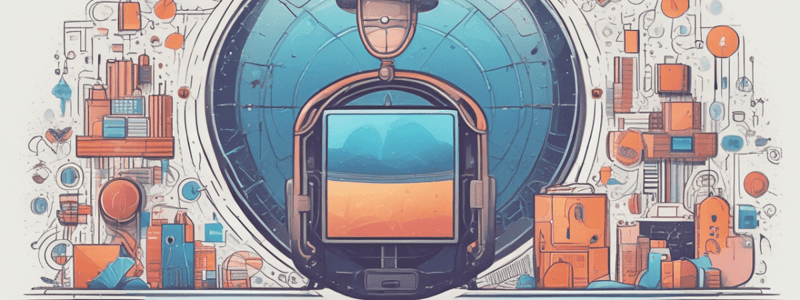Podcast
Questions and Answers
What type of information is collected at e-commerce sites?
What type of information is collected at e-commerce sites?
- Only personally identifiable information
- Only anonymous information
- Neither personally identifiable information nor anonymous information
- Both personally identifiable information and anonymous information (correct)
What is a unique challenge posed by social networks?
What is a unique challenge posed by social networks?
- Maintaining privacy (correct)
- Encouraging sharing personal details
- Monetizing social networks
- Sharing personal details
What is a concern with smartphone apps?
What is a concern with smartphone apps?
- They do not require permission to access device data
- They collect personal information for targeting ads (correct)
- They do not collect personal information
- They do not track user locations
What is profiling in the context of online behavior?
What is profiling in the context of online behavior?
What is the purpose of advertising networks?
What is the purpose of advertising networks?
What is the name of Google's program that involves profiling and behavioral targeting?
What is the name of Google's program that involves profiling and behavioral targeting?
What is the primary goal of psychographic research in online consumer behavior?
What is the primary goal of psychographic research in online consumer behavior?
What is the primary factor that influences online consumer behavior, according to the general online behavior model?
What is the primary factor that influences online consumer behavior, according to the general online behavior model?
What is the term used to describe the analysis of consumer behavior based on their online activities, such as number of days since last visit and number of products viewed?
What is the term used to describe the analysis of consumer behavior based on their online activities, such as number of days since last visit and number of products viewed?
What percentage of Internet users are shoppers, according to the data?
What percentage of Internet users are shoppers, according to the data?
What is the term used to describe the influence of online activities on offline retail purchases?
What is the term used to describe the influence of online activities on offline retail purchases?
What is the primary benefit of using clickstream data in marketing?
What is the primary benefit of using clickstream data in marketing?
What is a key finding regarding Internet access in households in 2012?
What is a key finding regarding Internet access in households in 2012?
Which demographic factors influence online usage?
Which demographic factors influence online usage?
What is a key lifestyle impact of Internet usage?
What is a key lifestyle impact of Internet usage?
What do consumer behavior models aim to explain?
What do consumer behavior models aim to explain?
What is an example of a background demographic factor?
What is an example of a background demographic factor?
What is a type of reference group?
What is a type of reference group?
What is a characteristic of subcultures?
What is a characteristic of subcultures?
What is a component of a consumer's psychological profile?
What is a component of a consumer's psychological profile?
Flashcards are hidden until you start studying
Study Notes
Information Collected at E-commerce Sites
- Personally identifiable information (PII) is collected, including name, address, phone, e-mail, and social security number
- Anonymous information, such as bank and credit accounts, gender, age, occupation, and education, is also collected
- Preference data, transaction data, clickstream data, and browser type are collected as well
Social Networks and Privacy
- Social networks encourage sharing personal details, posing a challenge to maintaining privacy
- Facebook's facial recognition technology and tagging feature collect personal information
- There is a conflict between personal control over personal information and the organization's desire to monetize social networks
Mobile and Location-based Privacy Issues
- Smartphone apps funnel personal information to mobile advertisers for targeting ads
- Apps track and store user locations
- 42% of users consider privacy a concern, and the Mobile Device Privacy Act aims to inform consumers about data collection (although it has not been passed)
Profiling and Behavioral Targeting
- Profiling creates digital images of online individual and group behavior, including anonymous and personal profiles
- Advertising networks track consumer behavior on the web, dynamically adjust what the user sees on the screen, and build and refresh consumer profiles
- Google's AdWords program is an example of this
Online Purchasing Decision
- Psychographic research combines demographic and psychological data to divide markets into groups based on social class, lifestyle, and/or personality characteristics
- The stages in the consumer decision process include: awareness of need, search for more information, evaluation of alternatives, actual purchase decision, and post-purchase contact with the firm
Model of Online Consumer Behavior
- The decision process is similar for online and offline behavior
- Online behavior is influenced by consumer skills, product characteristics, attitudes toward online purchasing, perceptions of control over the web environment, and website features like latency, usability, and security
- Clickstream behavior includes factors like the number of days since the last visit, speed of clickstream behavior, and number of products viewed during the last visit
Clickstream Marketing
- Clickstream factors are used to develop dynamic marketing strategies
- Clickstream behavior includes the number of days since the last visit, speed of clickstream behavior, and number of products viewed during the last visit
Shoppers: Browsers and Buyers
- 88% of internet users are shoppers, with 72% being buyers and 16% being browsers who purchase offline
- One-third of offline retail purchases are influenced by online activities
- Online traffic is also influenced by offline brands and shopping, making it part of a continuum of consuming behavior
Studying That Suits You
Use AI to generate personalized quizzes and flashcards to suit your learning preferences.




